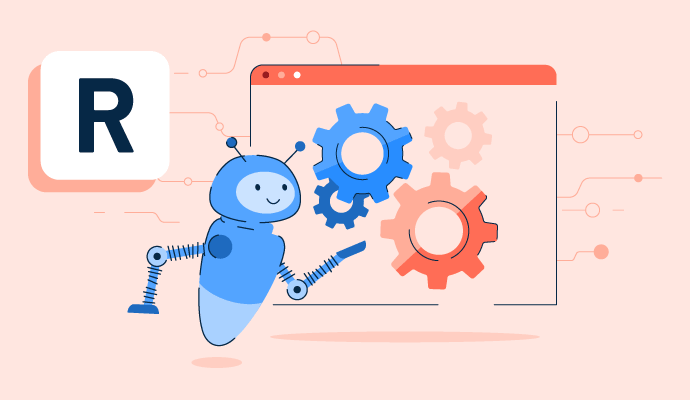What is robotic process automation?
Robotic process automation (RPA) is a rapidly evolving technology that uses software robots to carry out business-oriented tasks. It helps engineers maintain vast volumes of data without manual intervention.
RPA stems from business process automation, whereby robotics automation handles tasks like updating user data, evaluating queries and maintaining databases. Many organizations use robotic process automation software to perform routine tasks within software applications.
Software robots integrate into any system per the requirements and deliver outcomes comparable to those produced by humans regarding speed and accuracy.
How does RPA work
RPA involves using software robots to handle routine, rule-based digital tasks like entering the same data repeatedly, copying and pasting, and filling out forms. It helps enterprises delegate routine administrative tasks to machines as per all regulations.
Two fundamental steps are required to implement robotic process automation (RPA):
- Users must establish guidelines for when and what actions a bot is expected to perform.
- The bot is then initialized by RPA software to perform the task.
Three software elements typically make up an RPA environment. They are as follows:
- RPA bots, or software robots, are the so-called digital workforce that tackles tasks head-on.
- A bot designer or a studio: A platform for creating, configuring, and automating bots for business processes.
- An orchestrator: A control room for the integration, scheduling, monitoring, and management of bots.
Depending on the company's objectives, these elements may be arranged differently. This combination is frequently sufficient for smaller businesses, a studio where developers can create automation scenarios, and a bot that can run those scenarios when needed. Contrarily, enterprise-level businesses need an entire three-tier architecture to support numerous complex automation workflows and integrations.
Features of RPA
Many choices are available when selecting the best RPA solution. Finding one that's a good fit is essential, just like with so many business decisions, so companies ought to look for one that is:
- Simple to use. Every employee should be able to create and utilize bots. Additionally, they should be able to gather the information that allows leadership to make decisions.
- Scalable. Select an RPA platform that can be managed from a single location and expanded to as many regions as necessary.
- Rapid. Users can quickly design and test new robotic processes and optimize the bots with the best solution.
- Smart. The best tools can read and write to any data source, support simple task-based activities, and utilize advanced learning to enhance future automation.
Types of robotic process automation
RPA is effective at streamlining procedures. Each RPA includes key characteristics like platform independence, scalability, and intelligence. It provides the ideal balance between risks and benefits and considers cost-efficiency for the value gained.
Below are three categories of robotic process automation.
- Attended automation tools need assistance from a human to complete automation tasks. While a human employee is working, a bot or agent passively resides on a computer, waiting for the employee to activate it. Since the triggering points are challenging to detect programmatically, the user must actively do it. Attended RPA can be viewed as more of an addition than a total automation solution.
- Unattended automation devices intelligently make decisions. Precise execution isn't required for all tasks in a process. They can produce the output while operating in the background. This can save time for the back-end staff, who deal more with data and processes than customers.
- Hybrid RPA can perform attended and unattended automation tasks. RPAs that offer the best of both worlds are necessary for improving the processes' robustness and efficiency in today's large organizations, which have both a supportive environment and a back-end environment. Although RPA may not be as comprehensive as artificial intelligence (AI) regarding automation, this shortcoming makes it more effective and valuable. It's better to outsource some process automation to algorithms rather than relying entirely on RPA to automate it and risk mistakes. As a result, you protect human error from everyday life and automation error from lateral human thinking.
Benefits of robotic process automation
RPA enables businesses to automate procedures and jobs by setting up bots to complete them. Below are a few key benefits of robotic process automation.
- Cost savings: Using RPA for business process automation is less expensive than hiring people to perform the same tasks.
- Better accuracy: RPA produces more accurate results than manual work.
- Lower operational risk: RPA uses robots rather than humans to complete tasks, producing error-free results and minimizing the likelihood of errors.
- Reduces workloads: RPA can handle several organizational tasks, enabling the workforce to work on more critical things.
- Reduces manual efforts and time: RPA expedites a process that may take a long time when done manually.
- Flexibility and simplicity: RPA can easily integrate into a system without extensive coding, making it simple.
Robotic process automation vs. business process management
Robotic process automation is a software technology that automates repetitive tasks previously carried out by people. It sets up bots or employs software robots to finish tedious and time-consuming tasks. Human workers then have time to concentrate on more complex and vital tasks. Its business objective is to use software robots to cut costs.
Business process management (BPM) is a comprehensive technology that controls business functions for the highest level of effectiveness and value. For a short cycle, it pinpoints the business process and eliminates bottlenecks. It has the business objective of reengineering fundamental procedures and critical tools.
Learn more about business process management software to define, automate, and report on processes critical for delivering business goals.

Sagar Joshi
Sagar Joshi is a former content marketing specialist at G2 in India. He is an engineer with a keen interest in data analytics and cybersecurity. He writes about topics related to them. You can find him reading books, learning a new language, or playing pool in his free time.

